How to recommend the right products to your online shoppers
Sophia Lelew
Share post
These days, customers are flooded with masses of product information and promotions. In most purchase decisions, the choice is so overwhelming that they don't even know what to buy anymore.
To prevent customers from leaving your website dissatisfied, intelligent recommendation behavior helps you to create a personalized and user-friendly shopping experience. Displaying the right products or services to the right customers is not only key in terms of providing truly relevant content but is also the key to success in winning and retaining customers while also successfully engaging with them.
We are all familiar with the more conventional ways of trying to guide our customers through our e-commerce website. For example, 90% of all online shops have a faceted search engine or standard menu and category navigation bar. It's something a customer simply expects to see — but as e-commerce develops and retailers sell more online, customers require more advice and guidance.
Artificial intelligence is transforming retail to make online shopping more efficient and personalized with the help of predictive analytic tools and Guided Selling systems such as Product Guides and Digital Advisors.
In this blog post, we will go into:
- Why conventional search systems such as faceted search engines don't quite make the cut in the advancing world of e-commerce
- How you can discover whether your website or shop has suitable mechanisms in place to provide customers with good recommendations
- The steps you can take to improve your shop's user experience and navigation
- The latest kinds of recommender systems available to you on the market right now
as e-commerce develops and retailers sell more online, customers require more advice and guidance
Conventional search systems: Out of touch with your customers
The faceted search
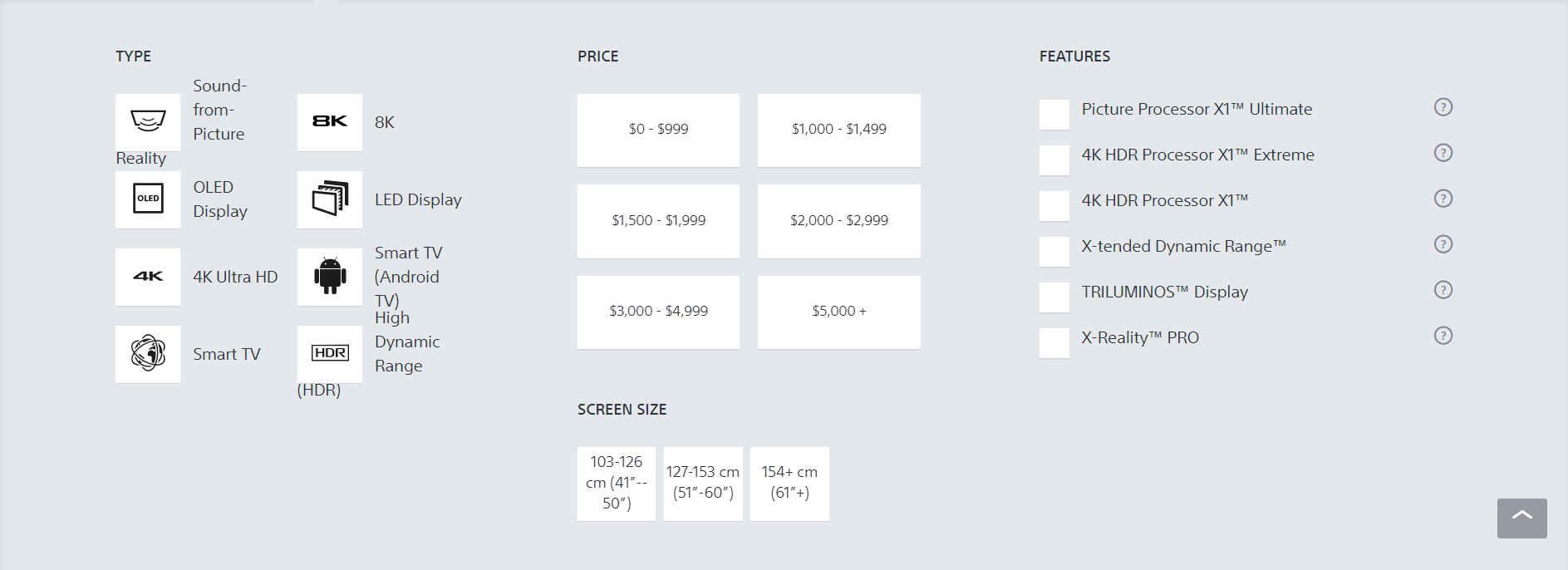
Source: Sony
Unenticing and filled with technical detail which not every customer will be familiar with, this faceted search provides no assistance to customers who are unsure of what they need or want.
The faceted search is also a distant resemblance from how humans would naturally interact and converse since it is unable to advise customers on what product to buy.
Menu/category navigation
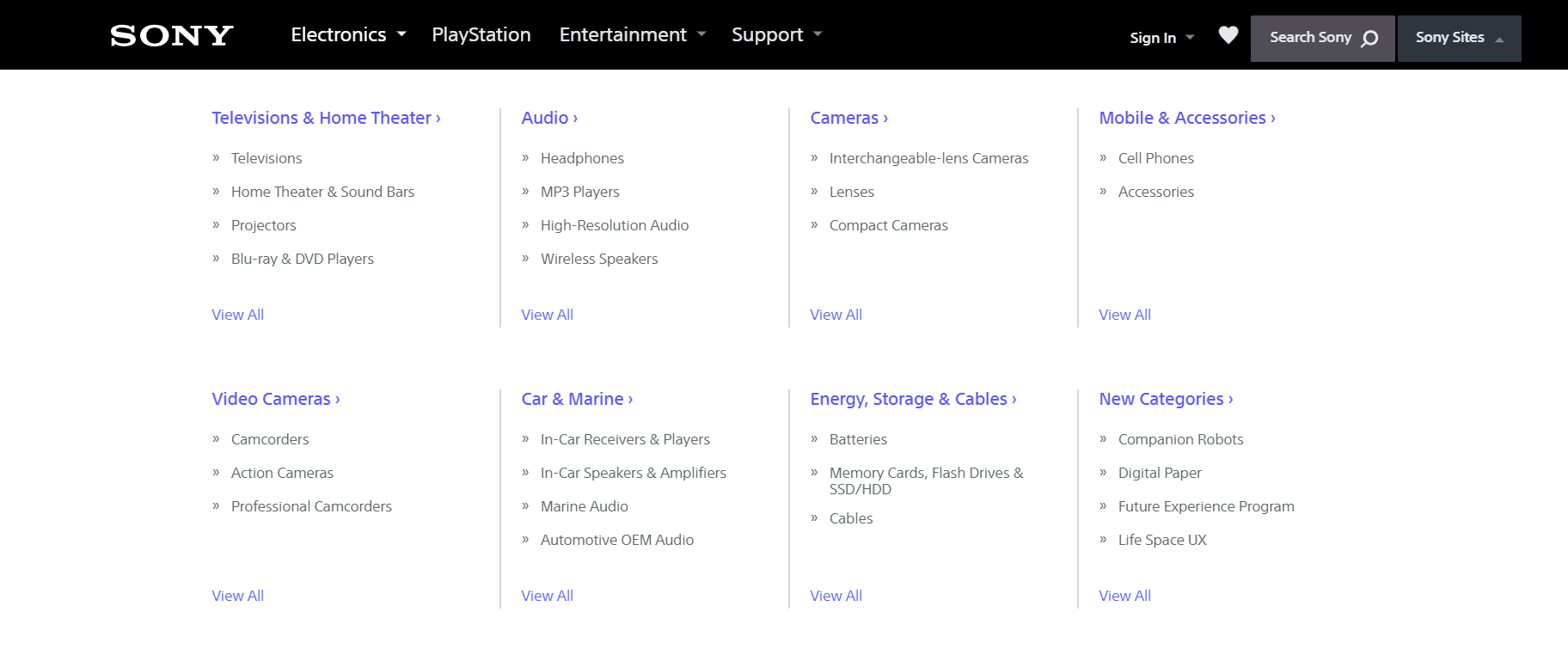
Source: Sony
Naturally, a must-have on any website, the menu/category navigation helps to filter out different kinds of products but is unable to advise any further. Once the user has said which kind of product they are looking for, they reach a dead-end.
Once the user has said which kind of product they are looking for, they reach a dead-end.
What is a good recommendation?
It all starts with understanding your customers and being able to map out the customer journey from their perspective. This way you can fulfill the requirements of every individual customer and provide them with intelligent product recommendations which are relevant to them.
Technically, it is complex to achieve good recommendation behavior but if you take it down a level, you can think about it in a less-abstract manner. Imagine your most charming sales rep. from one of your stores. They know exactly how to transform any customer's requirements into valuable recommendations that the customer will most likely buy.
Good recommendation behavior means that products or solutions are displayed in a results list, presenting the most suitable products first. The products you recommend should not only suit the customer's individual needs but also support your company's sales and marketing strategy.
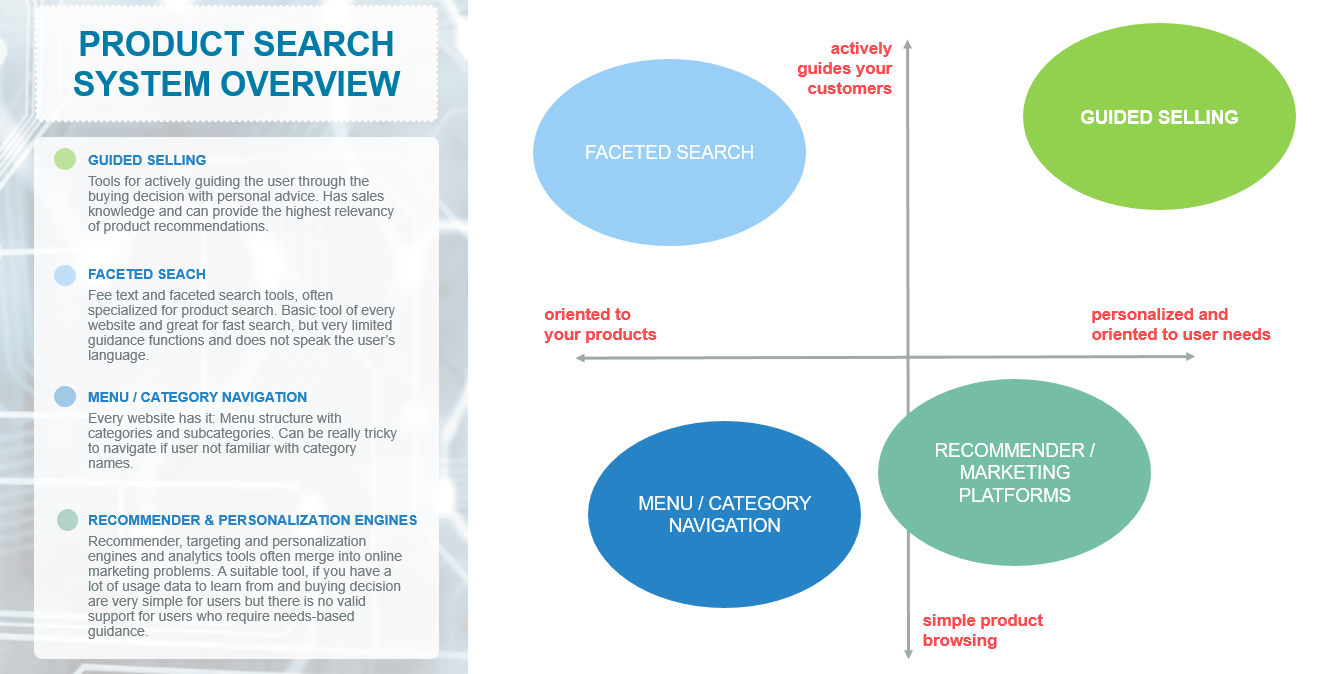
An overview and analysis of different kinds of product search and recommender systems and what they achieve.
It all starts with understanding your customers
Does my e-commerce site already provide good enough recommendations to my customers?
Check for H.A.C.K!

Human Factor
Does your e-commerce site mirror real-life human interaction and conversation?For example, does a user feel like they are being provided with advice and guidance, despite shopping online and not in-store?
Analytics
Do you have any way of tracking the performance of your product search?Can you extract useful data and analytics from it, which not only provides you with valuable consumer insights but also allows you to make strategic changes to your recommendation behavior?
Conversion
Are your customers converting?Check whether important product features are highlighted. Are there a nice combination of product images and other content, such as: key facts, user reviews, several product images etc.? These factors can assist in pushing a customer to the cart since they create trust and demonstrate expertise.
How many products do you show? Do you provide customers with a personalized, comprised list or do you show as many product listings as possible leading them to become overwhelmed?
Knowledge
Do you have power over what recommendations you provide customers with?Are you able to control which recommendations are relevant in which situation? Or is the recommender solely trained on past usage data?
H.A.C.K
Website with Guided Selling
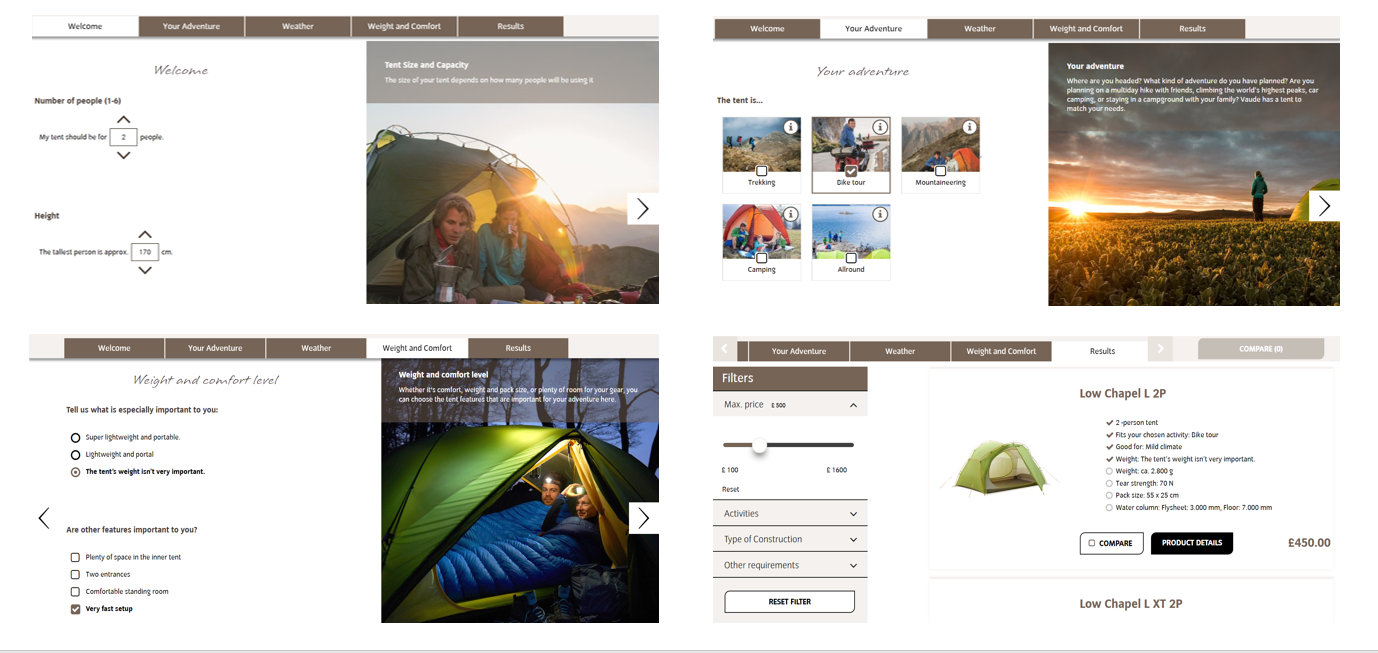
Source: VAUDE Tent Adviser
✓ Users don't need to search far and wide to find the most suitable products
✓ Users with no prior knowledge about what they are looking for can be easily guided and advised
✓ Users are presented with product explanations which inform them which products would suit their needs best and why
✓ Users are provided with a comprised list which is personalized and only shows the most relevant recommendations
Users with no prior knowledge about what they are looking for can be easily guided and advised
Website without Guided Selling
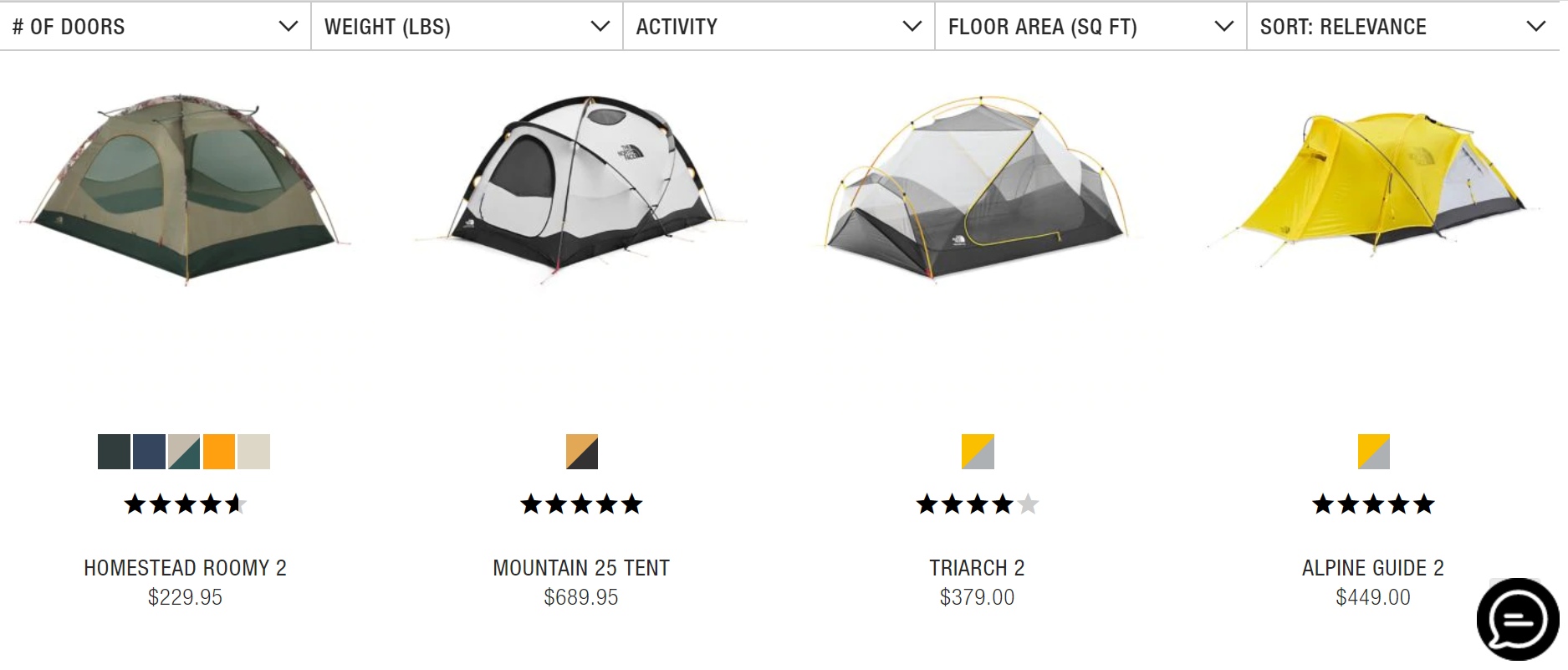
Source: North Face
✗ All products are mixed together so the user has to figure out which would suit their needs best
✗ Filters such as weight (lbs) and floor area (sq ft) are too specific and many users would not know what size or weight they require
✗ The order of the results list is not personalized to the individual user's needs
Filters such as weight (lbs) and floor area (sq ft) are too specific
How do you build a Guided Selling recommendation system?
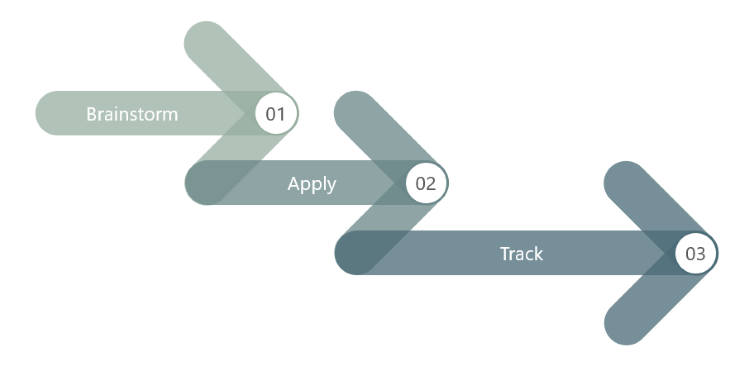
1. Brainstorm
- Put yourself in the mind of your customer
- Map out their shopping journey from when they enter your online shop until they reach the checkout
- What information do they require when considering a purchase?
- Consider the complexity of your product. If your products are more personal and less dependent on the specifics, you will require questions which focus more on personality traits and behavioral tendencies. It could be anything from fashion products, perfume, books, home and lifestyle products, toys — or maybe even holidays.
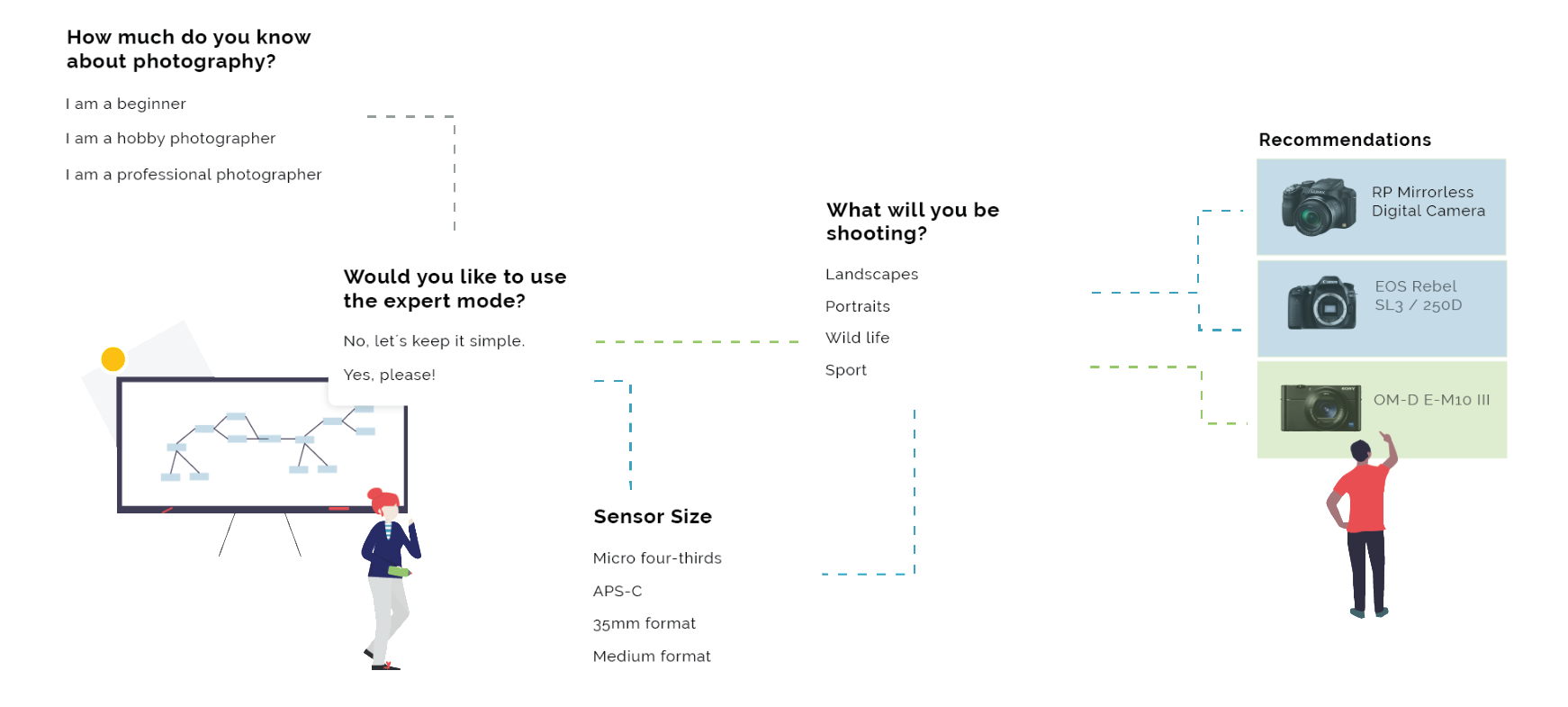
A tree diagram which maps out part of a customer's journey and possible thought process when buying a camera.
2. Apply
- Apply this knowledge to create a question flow and product recommendations for your Product Guide
- Include relevant attributes, such as personal requirements, which device type is appropriate to the user, sizing, price ranges, preferred brands etc.
- Find a software company who can build your Product Guide. They will need to combine your consumer knowledge with your product data, in order to make a well-functioning guide which you can easily integrate into your website.
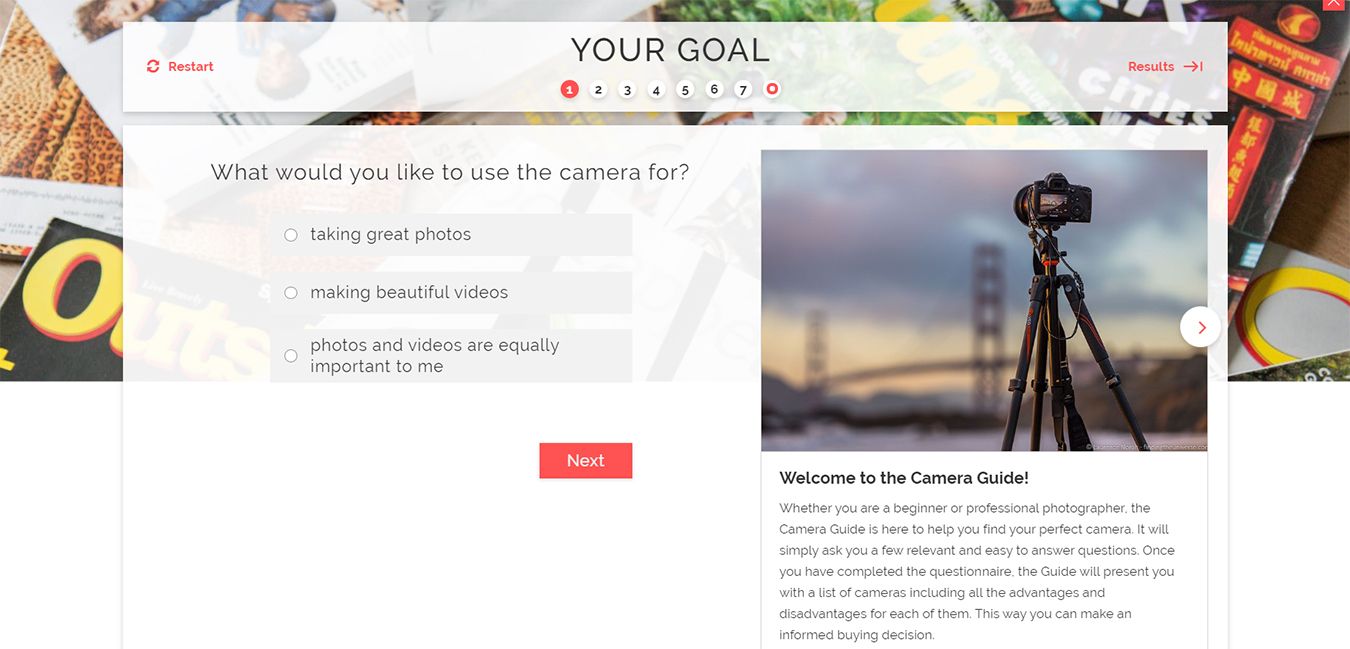
A completed Product Guide designed to advise people when buying a new camera
3. Track
- Optimize your Product Guide with analytics tools and track your success
- Find out which products people buy most with the Product Guide
- Where do people click and where do they drop off?
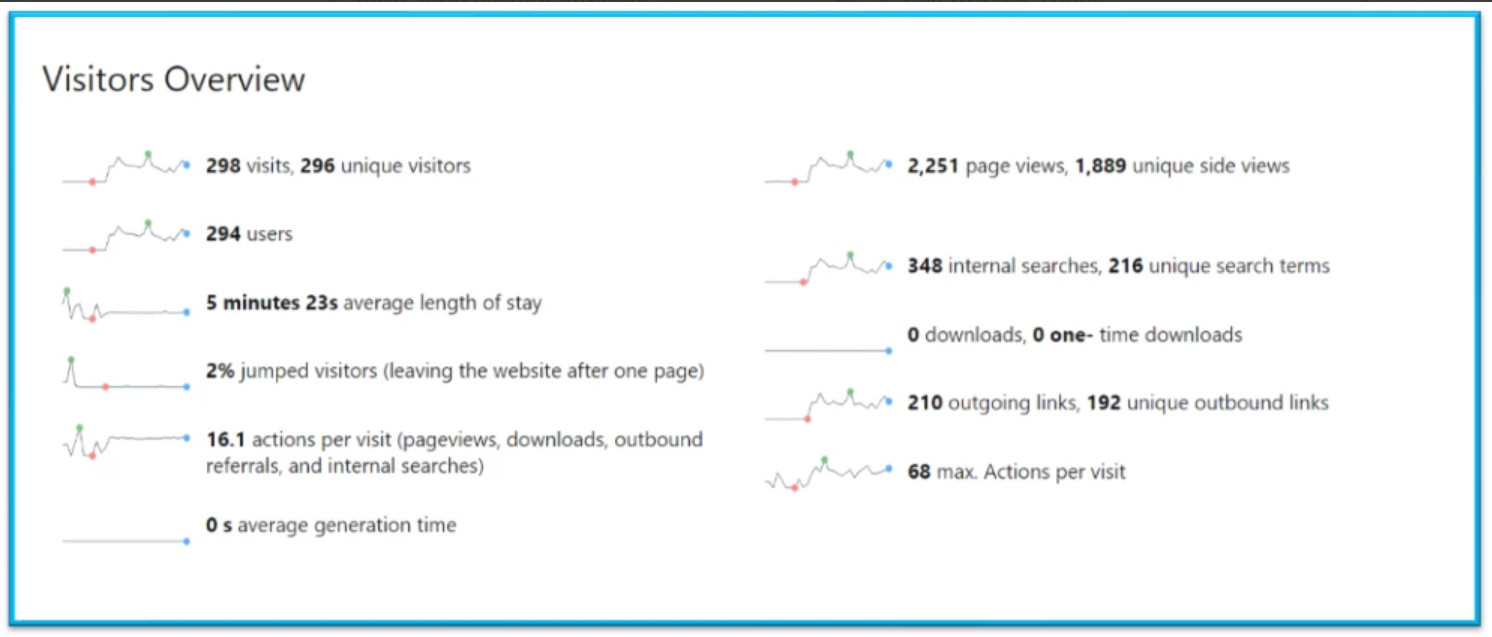
Example of data sample taken from one day period of the Product Guide after going live. It shows intense usage with 16 actions per visit and a long visit duration with over 5 minutes
Where do people click and where do they drop off?
Transferring consumer insights into more personalized recommendations
Consumer insights extracted from Product Guides help companies with future targeting since the recommendations provide useful information, such as: purchase and returns history, preferred brands, size and measurements, preferred colors etc. This allows you to offer more personalization through cross-selling recommendations, more insightful email marketing campaigns and landing pages which provide relevant recommendations.
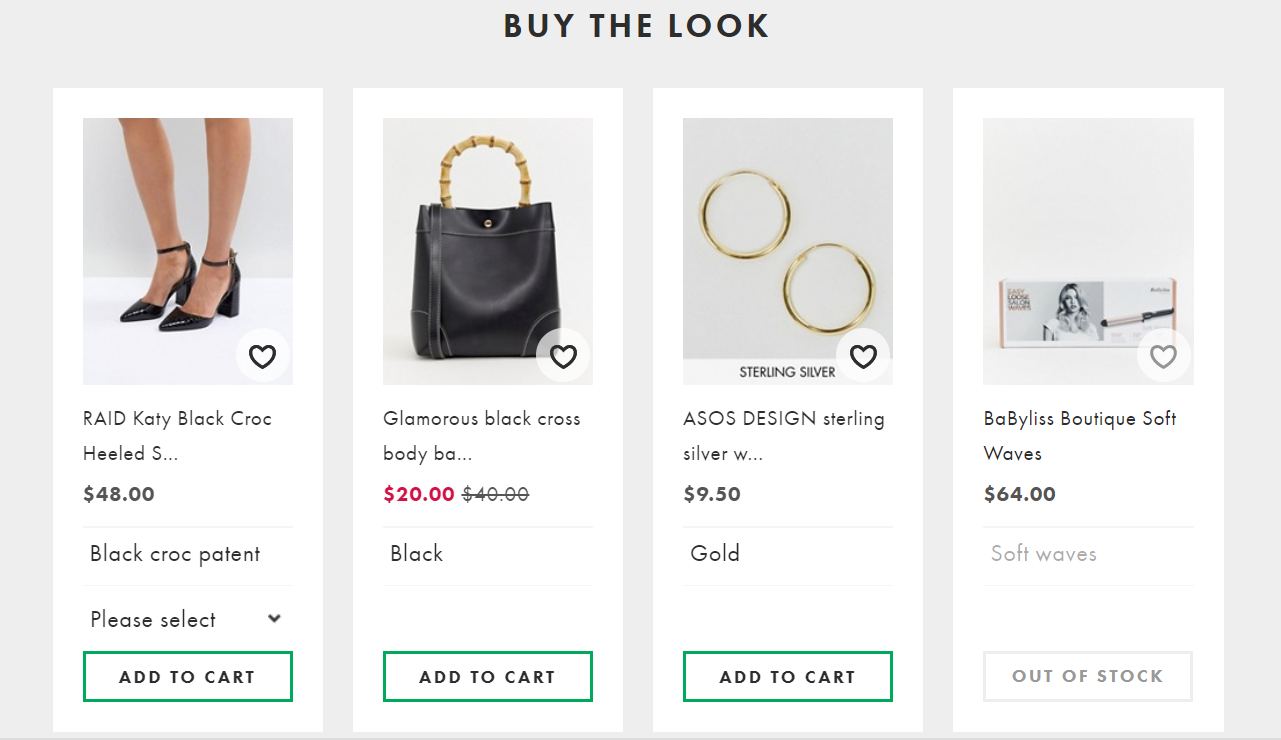
Source: Asos
Personalized recommendations and styling advice calculated from the user's buying/browser history are great upselling features and allow you to showcase more products which your customer is bound to love.
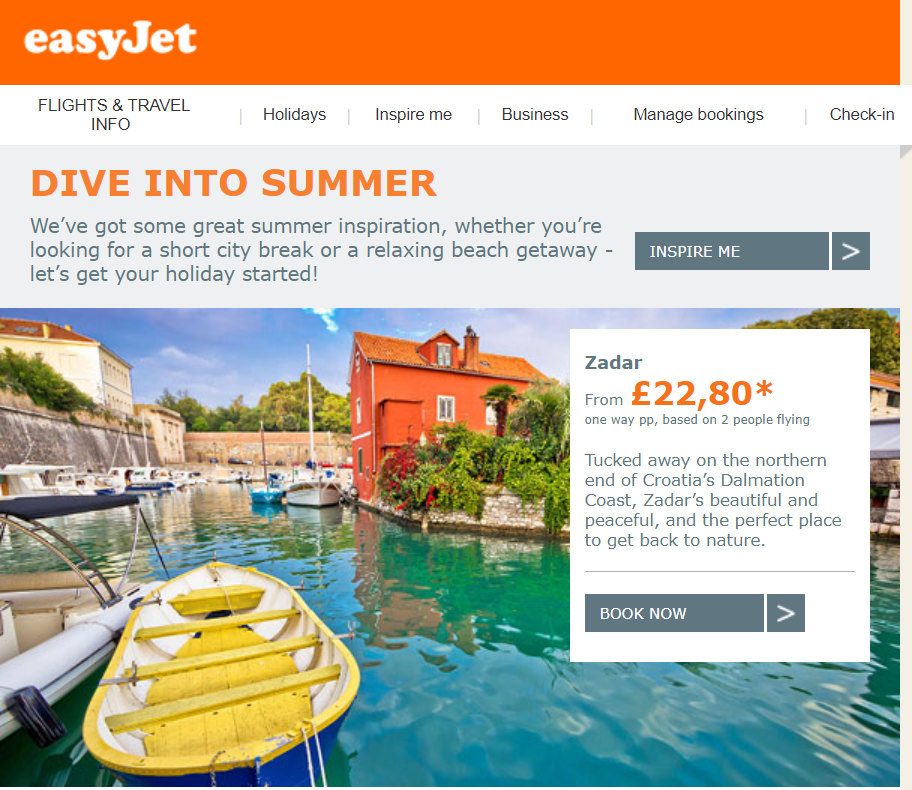
Source: Easyjet
Email marketing based on a customer's purchase history, browser history or user segment data is the ideal way to tempt customers back into your shop.
Landing Page Recommendations
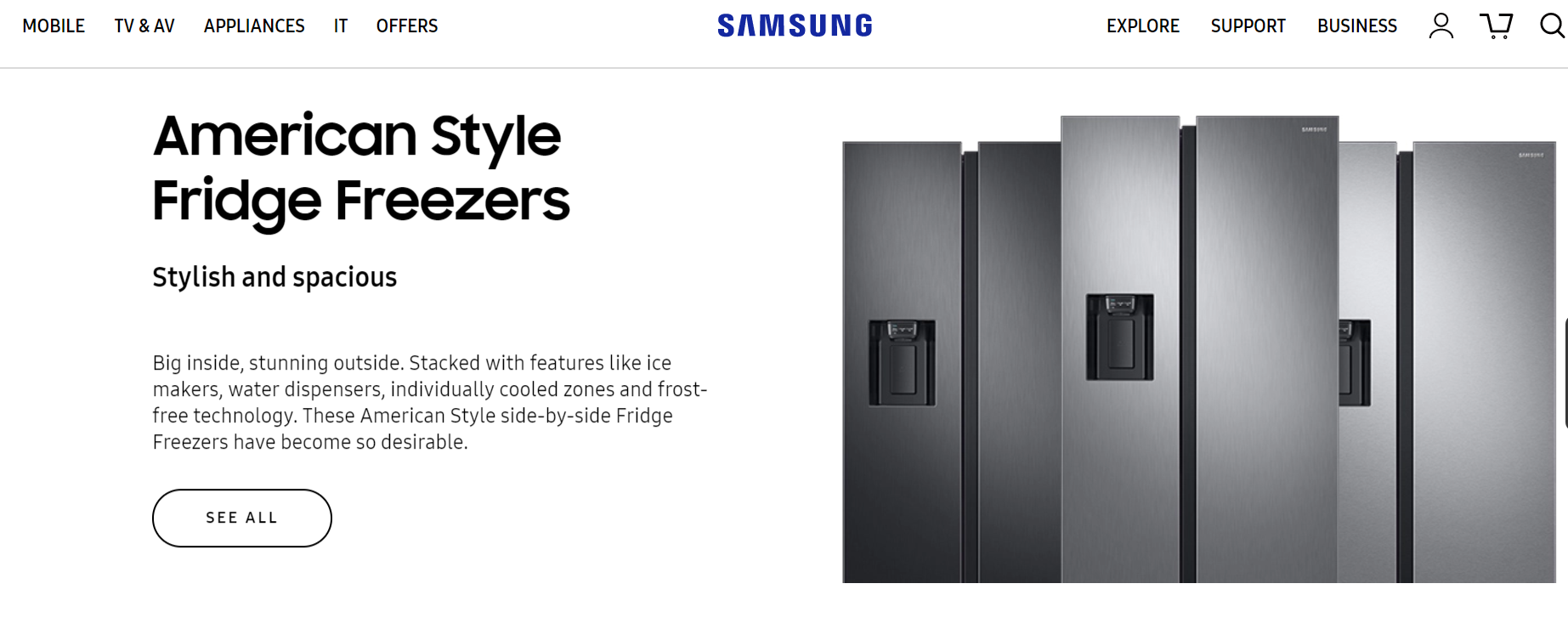
Source: Samsung
Welcome new customers onto your website. Creating landing pages for popular products allows you to attract new customers and increase traffic to your shop.
Product Guides help companies with future targeting


